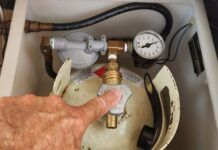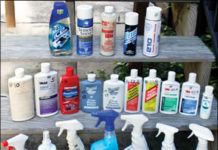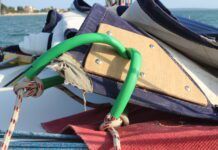What Are the Best Options in Hose Clamps and Barbs?
In “Stainless Steel Hose Clamps,” February 2016, we reviewed hose clamps by testing corrosion resistance and clamping security. Not a lot has changed; cheap...
Refurbishing the Inflatable Dinghy
Inflatable tenders have become the family car for many cruisers. They haul groceries, take us to snorkeling spots, shuttle guests, haul out second anchors,...
The Best Gloves for the Boatyard
We choose our sailing gloves and deck shoes with great care, because they are our interface with the boat. The same goes for work...
A Brief Modern History of Fiberglass
Fiberglass, also known as glass-reinforced plastic (GRP), has been an integral material in modern engineering and design, especially within the marine industry. Its lightweight,...
Propane Leak: How to Detect, Locate and Fix
There isn’t much that scares or worries me when it comes to all things about boats. Except two: large amounts of water coming in...
Sailing Triteia: Budget Bluewater Cruising
If I were to sum up, in one word, how James Frederick has managed to create his sailing life, I’d say “resourcefully.” The 49-year-old...
Boat Improvements for the Technically Illiterate
My wife Amanda often asks fellow cruisers the question: Would you prefer to sail with an experienced mechanic who knew little about sailing, or...
Whats the Best Way to Restore Clear Plastic Windows?
Preserving a clear view through clear plastic on dodgers or enclosures is one of the most challenging tasks in boat maintenance. Restoring a vinyl window is almost impossible, but that doesn't stop the tide of products that claim to make this job easy. Practical Sailors eisenglass cleaners test looks at 27 products touted primarily as cleaners or treatments for vinyl windows. The test products were divided into type: cleaners, scratch repairers, polish protectants, and UV protectants. After a week of testing, we found Imar Strataglass Protective Cleaner and Imar Strataglass Protective Polish, distributed by Defender Industries, to be the Best Choice. Collinite No. 845 Insulator Wax and Mer-Maids Plexiglass Plastic Cleaner and Polish were the Budget Buys. The test also included products from the following manufacturers: 303, 3M, Aquatech, Armada, Davies, Marykate, Meguiars. Mothers, Novus, Plexus, Sailors Solutions, Star brite, Turtle Wax, West Marine, and Yacht Brite.
Windlass Replacement on an Island Packet 40
At first I thought that standing on the V-head toilet and climbing awkwardly into the chain locker was funny. I tried not to think...
Getting a Clue for the Blown-Out Clew
How do you manage major sail repairs in remote locations? By using whatever you have onboard to get you home—or beyond.
After an easy three-day...


















































